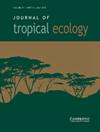印度纳康达姆偏远海洋岛屿上鱼尾棕榈(Caryota mitis Lour.)的食草动物和种子捕食现象
IF 1
4区 环境科学与生态学
Q4 ECOLOGY
引用次数: 0
摘要
海洋岛屿由于其进化历史和与世隔绝的特点,具有高地方性和易灭绝的双重角色,大多数已知的物种灭绝都发生在岛屿上。植物与动物之间的相互作用在岛屿上尤为重要,因为岛屿系统的冗余度通常较低,更容易受到物种灭绝或入侵物种的破坏。在这里,我们研究了偏远海洋岛屿纳康达姆(Narcondam)上的关键棕榈树 Caryota mitis 的果实移除和种子捕食情况。岛上特有的纳康达姆犀鸟(Rhyticeros narcondami)是该棕榈树的唯一种子传播者(90小时;N = 15棵树),平均(± SE)拜访率为每小时0.23(± 0.06)只,每次拜访摘果率为3.5(± 1.5;范围:0-16)枚果实,这表明该棕榈树的种子传播在该岛上缺乏冗余。而入侵的啮齿类动物 Rattus cf. tiomanicus 是棕榈种子的唯一捕食者(N = 15 个结果的棕榈个体,416 个诱捕夜)。总体而言,17.1% 的种子(N = 375 粒)被移走。在树冠下和远离树冠的地方,以及在不同密度下(2 个地块,每个地块有 10 粒种子;1 个地块,每个地块有 5 粒种子),种子被移走的比例相似。这表明种子捕食与密度无关,而且 Caryota mitis 缺乏安全的再生场所,这可能会对 "种子传播周期 "的后续阶段产生有害影响。在这里,我们从一个缺乏数据的地点,提供了一种基石棕榈的植物与食草动物相互作用的基本信息,以及一种入侵啮齿动物的潜在影响。本文章由计算机程序翻译,如有差异,请以英文原文为准。
Frugivory and seed predation of fishtail palm (Caryota mitis Lour.) on the remote oceanic island of Narcondam, India
Oceanic islands, due to their evolutionary history and isolation, play a dual role of having high endemicity and being vulnerable to extinctions, with most known extinctions occurring on islands. Plant–animal interactions are particularly important on islands, as island systems generally have low redundancy and are more vulnerable to disruption either via extinction or by invasive species. Here, we examined the fruit removal and seed predation of a keystone palm, Caryota mitis , on Narcondam, a remote oceanic island. The island endemic Narcondam Hornbill (Rhyticeros narcondami ) was the sole seed disperser of the palm (90 hours; N = 15 trees), with mean (± SE) visitation rate being 0.23 (± 0.06) individuals per hour and fruit removal rates of 3.5 (± 1.5; range: 0–16) fruits per visit, indicating a lack of redundancy in seed dispersal of the palm on this island. Whereas the invasive rodent, Rattus cf. tiomanicus , was the sole predator of palm seeds (N = 15 individual fruiting palms, 416 trap nights). Overall, 17.1% of the seeds placed (N = 375 seeds) were removed. Seeds placed under and away from the canopy, and at different densities (2 plots with 10 seeds each; 1 plot with 5 seeds, respectively), showed similar removal rates. This indicates density-independent seed predation and the lack of safe regeneration sites for Caryota mitis , with potential deleterious effects on subsequent stages of the ‘seed dispersal cycle’. Here, from a data-deficient site, we provide baseline information on the plant–frugivore interaction of a keystone palm and the potential impacts of an invasive rodent.
求助全文
通过发布文献求助,成功后即可免费获取论文全文。
去求助
来源期刊

Journal of Tropical Ecology
环境科学-生态学
CiteScore
2.10
自引率
0.00%
发文量
44
审稿时长
18-36 weeks
期刊介绍:
Journal of Tropical Ecology aims to address topics of general relevance and significance to tropical ecology. This includes sub-disciplines of ecology, such as conservation biology, evolutionary ecology, marine ecology, microbial ecology, molecular ecology, quantitative ecology, etc. Studies in the field of tropical medicine, specifically where it involves ecological surroundings (e.g., zoonotic or vector-borne disease ecology), are also suitable. We also welcome methods papers, provided that the techniques are well-described and are of broad general utility.
Please keep in mind that studies focused on specific geographic regions or on particular taxa will be better suited to more specialist journals. In order to help the editors make their decision, in your cover letter please address the specific hypothesis your study addresses, and how the results will interest the broad field of tropical ecology. While we will consider purely descriptive studies of outstanding general interest, the case for them should be made in the cover letter.
 求助内容:
求助内容: 应助结果提醒方式:
应助结果提醒方式:


